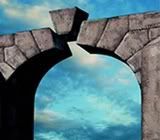Let's get some building terms straight.
Here is a typical roof (terms are UK of course)

The slates or tiles are nailed to battens which run from side to side and are nailed to the rafters. The rafters run from the wall plate at the bottom, to the ridge board at the top. The ridge board does not carry any weight. The rafters are supported by the purlin which spans between trusses or between gable ends.

Here is a nice example of a king post truss supporting two rows of purlins
I tell you all this in case you ever want to avoid using the generic fudge of "roof beams" to mean any bit of timber up in the roof!
Joists are "beams" which are laid horizontally to support the floor (floor joists) or ceilings (ceiling joists). I know, complicated names huh?!
The beam which supports the wall above windows or doors is called a lintel.
Here is something interesting. If you halve the width of a beam, it is half as strong and twice as bouncy. (technical term of course!). If you halve the depth of the beam it is only one quarter as strong and eight times as bouncy!
So - on to arches

The picture above shows us two things. First it helps us imagine what would happen if the keystone - the critical locking piece - is missing. You can just imagine the stones to either side simply sliding off into the river below. BUT with the keystone in place you can see how all the stones would be wedged together. What happens here is that all the vertical load you are putting onto the bridge (sorry, not making suggestions about your weight) is being translated into horizontal force at the ends of the arch. This is why you need something strong at either end to stop the arch from spreading.
We at arrive at last at this week's MYTH-BUSTER.
You remember this scene from The Fellowship of the Ring?

Gandalf is standing on the centre of the span, right on the keystone, facing down the Balrog. "You" he says. "Shall," he continues. "Not," he adds. "Pass!" With that he strikes the bridge and half of it collapses under the feet of the Balrog. Impossible! Either the whole bridge collapses or none at all. A more realistic version would be for the whole bridge to have collapsed taking both Gandalf and the Balrog into the abyss. Gandalf's final shout of "Fly you fools!" as he plummeted would have been even more poignant. It might not have made as good cinematics, but it wouldn't have made the engineer in me shake my head in despair!
Ah, these post are great, Dom. Now I'm thinking about arches. They're kinda of magical aren't they. How do they transfer the load into horizonatal forces? And the keystone underpins it all. There's a metaphor there.
ReplyDeleteThe pic has been removed by photobucket or some such!!!
ReplyDeleteBut I get you point!!! Sometimes it pays to grit one's teeth at such things!!! LOL!!!
Take care
x
Hi Deborah - The load is converted into horizontal forces (through the arch), because the pieces of the arch are wedge shaped. This means effectively that too much stone is trying to squeeze through a gap that is too narrow. At either end of the arch the forces are resolved into vertical components (which exactly equal the weight of the arch plus any load it is carrying, plus a horizontal force which equals the amount of compression of the stonework in the arch. Hope that makes it a little clearer than mud!
ReplyDeleteOld Kitty - ah! thanks for pointing that out. I have fixed it!
:Dom
Case in point. Pay attention to real facts even if you write fantasy. Thanks for the tips. I will forget them all because that's just me but I will remember who to ask.
ReplyDeleteNancy
N. R. Williams, The Treasures of Carmelidrium
I didn't know that! But I can see how it could effect someone who does. If you get the facts wrong things tend to get jumbled in the public. Great post!
ReplyDeleteYeah, those of us in information technolgy choke on our soda at least once in every related movie where people think they can delete a mainframe with one click of a button or upload viruses to the alien mother ship...*forehead slap*
ReplyDeleteFellow crusader saying hi. Hope you'll pop over to mine. I'm trying to start a "review club".
ReplyDeleteLouise x
I thought that the bridge was all one piece of stone and he shattered the half that the Balrog was standing on.
ReplyDeleteHey, Dom,
ReplyDeleteInteresting post. Yes, we all need to be aware in our writing. We need our readers to have all the information that is needed to create a believable story.
Michael
Dom,
ReplyDeleteI'm enjoying these posts so much! I do admit to having an understanding from my carpenter and builder daddy, but refreshers are always welcome.
Dom, once again a cool, informative post. I like the way you take information that could be dry and make it interesting. All engineers should be able to do that, but sadly most can't :-)
ReplyDeleteI'm embarrassed to admit you kind of lost me. My brain wandered when I got to: "king post truss supporting two rows of purlins." I thought it sounded like something from The Hobbit, and then your Gandalf myth buster became apropos due to my earlier mind meanderings. Aw, geez. It's getting late here and I'm on 3 hours sleep. LOL I'll come back tomorrow and read it again when I stand a better chance of understanding it. Forgive my feeble-mindedness. I promise to be smarter tomorrow. :)
ReplyDeleteHey, that scene in Lord of the Rings totally made sense to me. I never knew :)
ReplyDeleteBut I'm horrible at technological/architect stuff). I tend to not question things, but just accept. I'm bad that way.
Fellow crusader finally popping by to say hi and check out your pad. Looks nice over here. I'll be back :)
Good information, Dom. I reckon people misuse the word "rafters" a lot, too, to mean any old bit of wood up in the roof.
ReplyDeleteAs for the uncollapsed half of the bridge, would that, perchance, be an example of willing suspension of disbelief?
I hear you on the engineering impossibility of that Gandalf scene, but... He's magic! He's a servant of the secret fire, you know? I'm gonna let him keep half the bridge up if he says he can.
ReplyDeleteJai
Hey Dom, I got the link to a new website dedicated to helping writers with critique.
ReplyDeleteNancy
N. R. Williams, The Treasures of Carmelidrium
Wow! I'll never watch that scene the same again! Very interesting. :)
ReplyDeleteLOL! You remind me of my hubby when he watches films with railway scenes in them. He can usually identify a station or track location at twenty paces, so any anomologies are immediately commented upon :O)
ReplyDelete